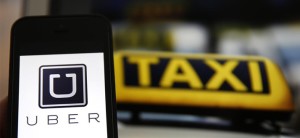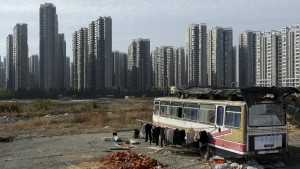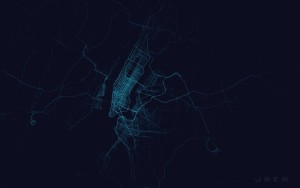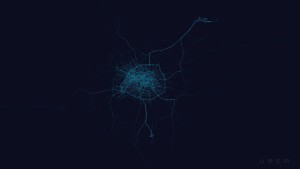
26 June 2015 – French taxi drivers have been warning for months to anyone willing to listen that their frustration over wildcat competition from Uber and similar ride-sharing services had reached a tipping point, and they weren’t going to stand for it any longer. It turns out they weren’t kidding.
Yesterday taxi drivers’ brewing hatred for Uber — and particularly the UberPop service that allows amateur drivers to pick up fares — spilled over into violence on the margins of a national strike against the American-based app, which was launched four years ago in France. Taxi drivers across France blocked roads and lit tire fires. In the southern city of Nice, local media reported that police had seized a Molotov cocktail from protesters.
NOTE: We are based in Paris and Brussels but do not use Uber. We use traditional taxis plus several on-line, fully licensed “black car” taxi services.
And on the French Uber website: “Strong demand on the Uber network — there is a taxi strike today, so demand will be strong and the service may be disrupted.”
The eruption of rage comes after months of legal wrangling over whether Uber can keep operating UberPop, the service that has concentrated most of the taxi drivers’ hatred. Last year, a French law banned UberPop and severely curtailed the activities of non-taxi chauffeur services. But in December, the Paris commercial court refused to ban UberPop, and the case was bumped up to the highest court in the land for a final decision.
Throughout the conflict, Uber has remained defiant and fought back against criticism by saying it will continue to expand despite the protests. While Uber’s lawyers have appealed to the European Commission to overturn the French ban on the grounds that it clashes with EU legislation, the company has continued to launch its service in new French cities, fueling yet more outrage from taxi drivers.
Oh, and it is such a mash-up of economics, politics, social justice, and the “French way” …
Despite Thursday’s violence, France’s socialist government sides with the taxis. Taxi unions complain that UberPop drivers are stealing fares and raking in profits while they drown under license-debt and struggle to pay for cars. Widely quoted in the French media was Claude Bartolone, president of the socialist group in parliament: “We can’t let taxi drivers succumb to a ‘survival of the fittest’ system”.
Nicholas Vinocur (who covers France for Politico) put it in a nutshell: “France’s Uber-taxi conflict, which has corollaries across Europe and even in the United States, boils down to anger over what taxi drivers feel is unfair competition from Uber. While licensed taxi drivers undergo rigorous testing, pay high social fees and shell out for licenses that sell for as much as €230,000 each in Paris, UberPop drivers face no such constraints. Taxi unions complain that UberPop drivers, who pay taxes on their sales but no social fees, are stealing fares and raking in profits while they drown under license-debt and struggle to pay for cars, which are often loaned to them at eye-watering daily rates by firms like G7 or Les Taxis Bleus”.
But French customers have cheered the arrival of Uber and if you follow the “café bavardage” most people feel Uber has broken the taxi firms’ longstanding monopoly over personal transport. Uber’s drivers tend to be friendlier than their licensed peers, and they offer perks like sweets or mineral water. When Uber’s controversial “surge-pricing” scheme is not in effect, its service tends to be cheaper. Most importantly, Uber fills a vacuum of supply during late-night hours on holidays and weekends — times when, just five years ago, it could be impossible to find a taxi in many French cities.
And to be fair, the competition has forced the traditional taxi companies to change. Several taxi companies now offer smartphone apps that allow customers to track their car’s progress, just like with Uber. Some have gone so far as to start stocking their cars’ magazine pockets with bottles of mineral water.
Authorities have also tried to change the equation. To make up for the lack of supply, the prefect in Paris and several other cities have issued thousands of new taxi licenses and upped recruitment of drivers over the past few years. But in the end, short of an outright ban on UberPop that would be difficult, if not impossible to enforce, the conflict can only be resolved by some balancing out of costs between overburdened taxis and under-burdened Ubers.
Guillaume Allègre (an economist at Sciences Po) has examined one radical solution which would be for the French government to buy up licenses at their current market value, freeing taxi drivers from debts that are the real source of rage against Uber. But Allègre found the cost of such an operation — €4 billion just for Paris, which has about 20,000 taxis — makes it prohibitive for a cash-strapped government already struggling to bring its public deficit down to European Union-imposed targets.
The latest phrase: “to be ubered”, or “humans-as-a-service”
Everyone is starting to worry about “being ubered”. It’s the idea that you suddenly wake up to find your legacy business gone, your clients confused, and your brand/business model upended. No sector seems to be safe from the “digital tsunami” causing it. It’s the “on-demand economy”, the best example of “convenience tech” sweeping our society. The popularity and success of Uber have inspired many entrepreneurs to build similar services in many other verticals and to call themselves “Uber of X”. Instacart for groceries, Upcounsel for legal services and Healthtap for medicine are a few examples I can think of. I believe that this is the ultimate impact Uber has had on the society: urging many other businesses/services to think about digital transformation. This has far more profound implications for the future of “full time employment”.
Because the most salient point is to look at Uber not as a taxi company but as a logistics software company. I’ve been researching the on-demand economy and this is a fascinating global trend that, in many ways, is more advanced outside of the U.S. than inside. China is a great example where, in many densely populated cities like Beijing, you can have almost anything delivered to your front door within an hour. There are unique circumstances that have allowed China to beat the U.S. to this punch, including a few that may never exist at mass in the U.S., a point relevant to any full on-demand economy analysis. But, like Uber, there are services that exist in China to let you track your package in real time, via a car or bike courier, letting you see exactly how long until your noodle soup or fresh groceries arrive at your house.
And it is why Uber has bid $3 billion for Nokia’s map software. Much of the Nokia value derives from the scarcity of comprehensive mapping technologies, which require significant investment and infrastructure to develop. Called “Here” — which was acquired by Nokia as Navteq in 2008 — is one of just a handful of companies that have sought to create their own mapping systems, together with Google, TomTom, and Apple. It’s extraordinarily difficult to get this type of mapping data. Other than Google, “Here” is one of the few companies that can offer this data right now.
And map data is rich. Just look at Uber’s usage maps. Last year it released maps of how its services are used in the 100 cities it in which it now operates. Releasing beautiful maps is a well-worn strategy for tech companies to get a little bit of free press. Foursquare, the location check-in app, released a bunch of maps last year, Facebook did the same, and Instagram regularly releases lists of the most photographed places in the world. But what makes Uber’s maps different is that they go beyond telling you about how the service is used — Foursquare’s maps, for instance, look like little more than night-time shots of cities from the sky — to reveal the demographic contours of cities.
Take the image of New York:
Uber is clearly popular on the island of Manhattan, and gets decent traffic out to Brooklyn. But few residents of Queens, which is poorer and skews older, seem to use the service. The Bronx is invisible.
Or Paris:
Paris is one large playground for the rich anyway, but note the areas outside the Périphérique, or ring road. While the desirable western suburbs feature on the map, the banlieues are, unsurprisingly, pretty bare.
It should, of course, come as no surprise that Uber users tend to be younger and richer. For one thing, they need a smartphone to access the service. Moreover, Uber remains a particularly American obsession. Those who use it in Europe, where public transport and decent cabs are plentiful, or in other countries, where car service is expensive, are likelier to be younger and more connected to American trends.
The commercial value of precise geolocation data is not lost on Uber. Consumer products and services make consumers’ lives easier and more efficient, and geolocation information can reveal a consumer’s movements in real time and provide a detailed record of a consumer’s movements over time. (For a more detailed analysis see my piece “Geolocation, privacy and e-discovery”).
We believe Uber’s real upside in software is to provide this turnkey logistics/analysis platform to others who can use it in the on-demand economy. For example, UPS or FedEx could license this from Uber so I get a message the second the delivery truck is on the way to my house with my package, allowing me to keep track of the truck so I will know exactly when it arrives. There are many current applications for this but perhaps another big upside is how Uber can take advantage of their growing driver work force. For those of you who read my “deep dive” into Uber my line of thinking was simple: job creation, via willing delivery agents in nearly every city. Think about this as the new pizza delivery job. The modern age equivalent is to drive for Uber and deliver whatever the customer needs, not just pizza.
Yes, yes, yes. There is the dark side.

There is no Uber for this
It did not take technology to spur the on-demand economy. It took masses of poor people. The conventional narrative is this: enabled by smartphones, with their GPS chips and internet connections, enterprising young businesses are using technology to connect a vast market willing to pay for convenience with small businesses or people seeking flexible work. This narrative ignores another vital ingredient, without which this new economy would fall apart: inequality.
As my good friend Leo Mirani has written “there are only two requirements for an on-demand service economy to work, and neither is an iPhone. First, the market being addressed needs to be big enough to scale—food, laundry, taxi rides. Without that, it’s just a concierge service for the rich rather than a disruptive paradigm shift, as a venture capitalist might say. Second, and perhaps more importantly, there needs to be a large enough labor class willing to work at wages that customers consider affordable and that the middlemen consider worthwhile for their profit margins. There is no denying the seductive nature of convenience — or the cold logic of businesses that create new jobs, whatever quality they may be”.
But the notion that brilliant young programmers are forging a newfangled “instant gratification” economy is a falsehood. Instead, it is a rerun of the oldest sort of business: middlemen insinuating themselves between buyers and sellers. All that modern technology has done is make it easier, through omnipresent smartphones, to amass a fleet of increasingly desperate job seekers eager to take whatever work they can get. Ask any contract attorney in e-discovery. She’ll tell you.





No comments yet... Be the first to leave a reply!